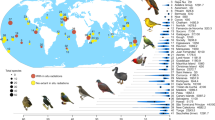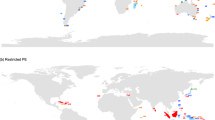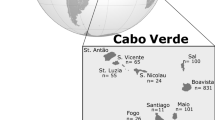Abstract
Oceanic islands have long served as natural laboratories for understanding the diversification of life1,2,3,4. In particular, the many thousands of islands spanning the tropical Pacific support an unparalleled array of terrestrial communities whose patterns of diversity contributed fundamental insights to the development of classical speciation and biogeographic theory4,5,6,7,8. Much of this work is founded on an assumption derived from traditional taxonomic approaches, namely that faunas on these widely separated archipelagos stem from a simple one-way, downstream flow of colonists from continents to islands2,4. Here we show, with the use of molecular phylogenetic data from one of the original bird families used to justify this assumption, that a diverse array of endemic island genera and species are the product of a single radiation that diversified across all major Pacific archipelagos in a non-stepping-stone fashion, and recently recolonized continental areas. The geographic scope and lineage-specific approach of this study reveal evolutionary patterns long obscured by traditional taxonomic surveys and indicate that widely dispersed archipelagos can be sources of biological diversity.
This is a preview of subscription content, access via your institution
Access options
Subscribe to this journal
Receive 51 print issues and online access
$199.00 per year
only $3.90 per issue
Buy this article
- Purchase on Springer Link
- Instant access to full article PDF
Prices may be subject to local taxes which are calculated during checkout


Similar content being viewed by others
References
Wallace, A. R. On the law which has regulated the introduction of new species. Ann. Mag. Nat. Hist. 26(2), 184–196 (1855)
Mayr, E. Systematics and the Origin of Species (Columbia Univ. Press, New York, 1942)
Lack, D. Darwin's Finches (Cambridge Univ. Press, Cambridge, 1947)
MacArthur, R. H. & Wilson, E. O. The Theory of Island Biogeography (Princeton Univ. Press, Princeton, 1967)
Diamond, J. M. Colonization of exploded volcanic islands by birds: the supertramp strategy. Science 184, 803–806 (1974)
Wilson, E. O. The nature of the taxon cycle in a tropical ant fauna. Evolution 13, 122–144 (1961)
Diamond, J. Continental and insular speciation in Pacific island birds. Syst. Zool. 26, 263–268 (1977)
Mayr, E. & Diamond, J. M. The Birds of Northern Melanesia: Speciation, Ecology and Biogeography (Oxford Univ. Press, New York, 2001)
Gillespie, R. G. Biogeography of spiders on remote oceanic islands of the Pacific: archipelagoes as stepping stones? J. Biogeogr. 29, 655–662 (2002)
Wright, S. D., Yong, C. G., Dawson, J. W., Whittaker, D. J. & Gardner, R. C. Riding the ice age El Niño? Pacific biogeography and evolution of Metrosideros subg. Metrosideros (Myrtaceae) inferred from nuclear ribosomal DNA. Proc. Natl Acad. Sci. USA 97, 4118–4123 (2000)
Mayr, E. The origin and the history of the bird fauna of Polynesia. Proc. VI Pac. Sci. Cong. 4, 197–216 (1939)
Filardi, C. E. & Smith, C. E. Molecular phylogenetics of monarch flycatchers (genus Monarcha) with emphasis on Solomon endemics. Mol. Phylogenet. Evol. published online, 11 March 2005 (doi:10.1016/j.ympev.2005.02.007)
Drovetski, S. V. et al. Complex biogeographic history of a Holarctic passerine. Proc. R. Soc. Lond. B 271, 545–551 (2004)
Grant, P. R. Reconstructing the evolution of birds on islands: 100 years of research. Oikos 92, 385–403 (2001)
Hall, R. in Biogeography and the Geological Evolution of SE Asia (eds Hall, R. & Holloway, J. D.) 99–131 (Backhuys, Leiden, 1998)
Steadman, D. W. Prehistoric extinctions of Pacific island birds; biodiversity meets zooarchaeology. Science 267, 1123–1131 (1995)
Olson, S. L. Lamprolia as part of a South Pacific radiation of monarchine flycatchers. Notornis 27, 7–10 (1980)
Tarr, C. L. & Fleischer, R. C. Mitochondrial DNA variation and evolutionary relationships in the Amakihi complex. Auk 110, 825–831 (1993)
Slikas, B., Jones, I. B., Derrickson, S. R. & Fleischer, R. C. Phylogenetic relationships of Micronesian white-eyes based on mitochondrial sequence data. Auk 117, 355–365 (2000)
Cibois, A., Thibault, J. C. & Pasquet, E. Biogeography of eastern Polynesian monarchs (Pomarea): an endemic genus close to extinction. Condor 106, 837–851 (2004)
Spironello, M. & Brooks, D. R. Dispersal and diversification: macroevolutionary implications of the MacArthur–Wilson model, illustrated by Simulium (Inseliellum) Rubstov (Diptera: Simuliidae). J. Biogeogr. 30, 1563–1573 (2003)
Ricklefs, R. E. & Bermingham, E. Nonequilibrium diversity dynamics of the Lesser Antillean avifauna. Science 294, 1522–1524 (2001)
Ward, S. A. & Thornton, I. W. B. Chance and determinism in the development of isolated communities. Global Ecol. Biogeogr. 9, 7–18 (2000)
Lomolino, M. V. Mammalian community structure on islands: immigration, extinction, and interactive effects. Biol. J. Linn. Soc. 28, 1–21 (1986)
Steadman, D. W. Biogeography of Tongan birds before and after human impact. Proc. Natl Acad. Sci. USA 90, 818–822 (1993)
Fjeldså, J. The origin of species in Melanesia. Trends Ecol. Evol. 17, 292 (2002)
Farris, J. S., Kallersjo, M., Kluge, A. G. & Bult, C. Constructing a significance test for incongruence. Syst. Biol. 44, 570–572 (1995)
Swofford, D. L. PAUP*. Phylogenetic Analysis Using Parsimony (*and Other Methods) (Sinauer Associates, Sunderland, Massachusetts, 2002)
Posada, D. & Crandall, K. A. Modeltest: testing the model of DNA substitution. Bioinformatics 14, 817–818 (1998)
Huelsenbeck, J. P. & Ronquist, F. MRBAYES: Bayesian inference of phylogenetic trees. Bioinformatics 17, 754–755 (2001)
Acknowledgements
This paper is dedicated to the memory of Ernst Mayr and his lifelong contribution to biology. We thank G. Barrowclough, J. Cracraft, R. Ricklefs, C. E. Smith and D. Steadman for comments. This work was supported in part by the F. M. Chapman Memorial Fund and by the L. C. and L. J. Sanford Funds of the American Museum of Natural History. The research was conducted in the Ambrose Monell Molecular Laboratory and is a contribution of the Lewis B. and Dorothy Cullman Program for Molecular Systematic Studies, a joint initiative of the New York Botanical Gardens and the American Museum of Natural History.
Author information
Authors and Affiliations
Corresponding author
Ethics declarations
Competing interests
Nucleotide sequences newly determined here have been deposited in GenBank under the accession numbers DQ084072–DQ084119. Reprints and permissions information is available at npg.nature.com/reprintsandpermissions. The authors declare no competing financial interests.
Supplementary information
Supplementary Notes
This file includes Supplementary Methods, Supplementary Discussion, Supplementary Tables 1–3 and Supplementary Figure Legends. (DOC 115 kb)
Supplementary Figure 1
Maximum likelihood topology recovered using combined nuclear and mtDNA data, and ML bootstrap and Bayesian posterior probability values for all nodes in the tree. (PDF 1532 kb)
Supplementary Figure 2
This figure shows trees for each of the two genes analysed separately and also includes bootstrap and posterior probability information. (PDF 1676 kb)
Rights and permissions
About this article
Cite this article
Filardi, C., Moyle, R. Single origin of a pan-Pacific bird group and upstream colonization of Australasia. Nature 438, 216–219 (2005). https://doi.org/10.1038/nature04057
Received:
Accepted:
Issue Date:
DOI: https://doi.org/10.1038/nature04057
This article is cited by
-
Prevalence and diversity of avian haemosporidian parasites across islands of Milne Bay Province, Papua New Guinea
Parasitology Research (2022)
-
Norfolk Island Robins are a distinct endangered species: ancient DNA unlocks surprising relationships and phenotypic discordance within the Australo-Pacific Robins
Conservation Genetics (2016)
-
Islands contribute disproportionately high amounts of evolutionary diversity in passerine birds
Nature Communications (2015)
-
Assessing the potential for reverse colonization among Japanese birds by mining DNA barcode data
Journal of Ornithology (2015)
-
Palaeoclimatic events, dispersal and migratory losses along the Afro-European axis as drivers of biogeographic distribution in Sylvia warblers
BMC Evolutionary Biology (2011)
Comments
By submitting a comment you agree to abide by our Terms and Community Guidelines. If you find something abusive or that does not comply with our terms or guidelines please flag it as inappropriate.



